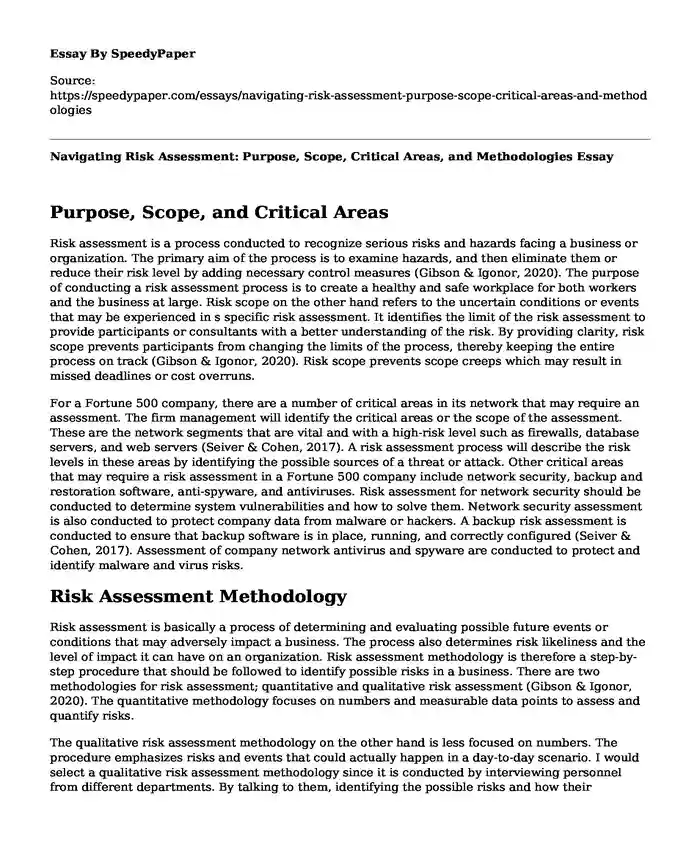Purpose, Scope, and Critical Areas
Risk assessment is a process conducted to recognize serious risks and hazards facing a business or organization. The primary aim of the process is to examine hazards, and then eliminate them or reduce their risk level by adding necessary control measures (Gibson & Igonor, 2020). The purpose of conducting a risk assessment process is to create a healthy and safe workplace for both workers and the business at large. Risk scope on the other hand refers to the uncertain conditions or events that may be experienced in s specific risk assessment. It identifies the limit of the risk assessment to provide participants or consultants with a better understanding of the risk. By providing clarity, risk scope prevents participants from changing the limits of the process, thereby keeping the entire process on track (Gibson & Igonor, 2020). Risk scope prevents scope creeps which may result in missed deadlines or cost overruns.
For a Fortune 500 company, there are a number of critical areas in its network that may require an assessment. The firm management will identify the critical areas or the scope of the assessment. These are the network segments that are vital and with a high-risk level such as firewalls, database servers, and web servers (Seiver & Cohen, 2017). A risk assessment process will describe the risk levels in these areas by identifying the possible sources of a threat or attack. Other critical areas that may require a risk assessment in a Fortune 500 company include network security, backup and restoration software, anti-spyware, and antiviruses. Risk assessment for network security should be conducted to determine system vulnerabilities and how to solve them. Network security assessment is also conducted to protect company data from malware or hackers. A backup risk assessment is conducted to ensure that backup software is in place, running, and correctly configured (Seiver & Cohen, 2017). Assessment of company network antivirus and spyware are conducted to protect and identify malware and virus risks.
Risk Assessment Methodology
Risk assessment is basically a process of determining and evaluating possible future events or conditions that may adversely impact a business. The process also determines risk likeliness and the level of impact it can have on an organization. Risk assessment methodology is therefore a step-by-step procedure that should be followed to identify possible risks in a business. There are two methodologies for risk assessment; quantitative and qualitative risk assessment (Gibson & Igonor, 2020). The quantitative methodology focuses on numbers and measurable data points to assess and quantify risks.
The qualitative risk assessment methodology on the other hand is less focused on numbers. The procedure emphasizes risks and events that could actually happen in a day-to-day scenario. I would select a qualitative risk assessment methodology since it is conducted by interviewing personnel from different departments. By talking to them, identifying the possible risks and how their operations would be affected by a breach or an attack would be easy and precise (Gibson & Igonor, 2020). Through the qualitative methodology of risk assessment, the assessor can enquire how a team’s productivity may be impacted by a lack of access to data, or specific applications and platforms. Talking to people will allow an evaluator to identify the mission-critical platforms and systems for specific teams and which areas are not critical. Although not as precise as quantitative assessments, qualitative assessment procedures provide important information since an attack may cause more than financial risks. By understanding a risk impact on a team’s productivity, it is easier to identify possible solutions to prevent the events or reduce their impacts.
References
Gibson, D., & Igonor, A. (2020). Managing risk in information systems. Jones & Bartlett Learning.
https://www.academia.edu/download/60842328/Darril_GibsonManaging_Risk_in_Information_Systems__-Jones___Bartlett_Learning__201120191008-53485-qe818f.pdf
Seiver, M., & Cohen, S. (2017). U.S. Patent No. 9,648,036. Washington, DC: U.S. Patent and Trademark Office.
https://patentimages.storage.googleapis.com/68/68/43/8126c448da0dd0/US9648036.pdf
Cite this page
Navigating Risk Assessment: Purpose, Scope, Critical Areas, and Methodologies. (2024, Jan 22). Retrieved from https://speedypaper.com/essays/navigating-risk-assessment-purpose-scope-critical-areas-and-methodologies
Request Removal
If you are the original author of this essay and no longer wish to have it published on the SpeedyPaper website, please click below to request its removal:
- Free Essay Sample: Associates in Avionics Technology
- Lighting and Employee Performance in the Free Essay on SpeedyPaper
- Essay Example on the Imperial Hotel: Poor Guest Satisfaction
- Learning Goals. Essay Example
- Free Essay. Impacts of Information Technology on Online and Brick-and-Mortar Stores
- Paper Example. Effects of Moral Principles on Business Decisions
- Gig Economy and Rise of the Contingent Workforce - Free Paper Sample
Popular categories





